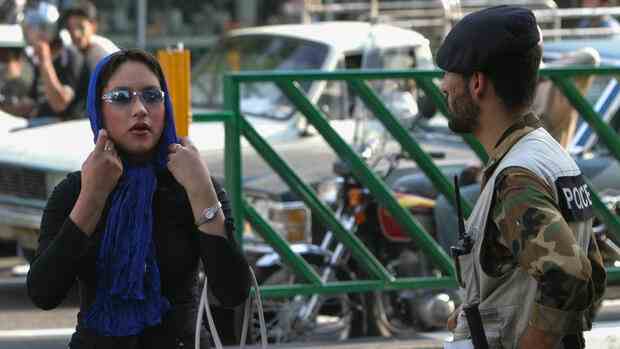Tel Aviv The protests in Iran are developing into a mass movement. Numerous businessmen kept their shops closed on Monday, apparently responding to a call for a three-day general strike.
The 380,000-follower Twitter account 1500tasvir, which closely follows the protests, shared videos showing boarded-up shops in downtown areas such as the bazaar in the capital Tehran and other cities like Karaj, Isfahan and Shiraz. Witnesses reported a massive Basij militia presence in central Tehran.
The semi-official Fars news agency reported that a jewelry shop owned by former soccer star and Bayern Munich player Ali Daei was sealed off by authorities after announcing it would remain closed for the three-day general strike.
Kurdish-Iranian human rights group Hengaw said 19 cities in western Iran, where most of the country’s Kurds live, have joined the strike. With the strike, the regime critics want to dry up the liquidity in the Iranian banking system and hit the economic nerve of the regime.
Top jobs of the day
Find the best jobs now and
be notified by email.
Because the protests have “significantly” subsided over the past week, compliance with the call for a strike is a “critical test” for the protest movement, says Tel Aviv Iran expert Raz Zimmt.
>> Read also: According to the Attorney General, Iran has dissolved the vice squad and announces a committee of inquiry
Two quotes from the Iranian Attorney General Mohammad-Jafar Montazeri caused a sensation at the weekend. He had been confronted with the question of whether the vice squad would be disbanded during a conference of clergymen on Sunday. His answer was open to interpretation.
The disbanding of the vice squad, established in 2005, was decided by a committee of government officials, he said, without giving details. The country’s Islamic courts would continue to monitor public behavior, he added. Earlier, Montazeri had announced in Parliament that the law obliging women to wear the hijab would be reviewed.
Fundamentalist Iranian women promote their religious values.
(Photo: IMAGO/NurPhoto)
However, he failed to say how the hijab law, which Montazeri described as “the dividing line between the West and Islamic culture,” would be enforced in the future. He also left open whether the powers of the moral police should be transferred to other police units.
Observers do not see this as an indication that the moral police will be abolished and that compulsory headscarves will be lifted. Montazeri’s statements were promptly put into perspective. The Ministry of the Interior, which is responsible for the moral police, did not confirm the abolition of the moral police. State media also said the judiciary was not responsible for overseeing the morality police.
Western media, which portrayed Montazeri’s statements as a “retreat of the Islamic Republic” on the hijab and morality issues, were wrong. “No official of the Islamic Republic of Iran has said that the vice squad has been abolished,” state media said.
Attempt to mollify the protest movement
A Tehran political scientist who wishes to remain anonymous describes Montazeri’s controversial statement as an attempt to appease the protest movement by indicating that the regime is willing to make concessions. “It’s a sedative, nothing more,” the political scientist told the Handelsblatt. Even if the moral police were to be disbanded, this would not mean that the headscarf requirement would be dropped.
The most recent statements by the Attorney General point to tensions within the regime, says the political scientist. Support for the hijab law remains high among conservative politicians and clerics. “This makes it difficult for Iran’s hard-line leadership to abolish the hijab law.”
The regime is under increasing pressure.
(Photo: IMAGO/ZUMA Wire)
Just a few weeks before the protests began, President Ebrahim Raisi publicly called for stricter enforcement of the law, state news agencies report. A Conservative MP last week demanded that women who are imprisoned for not wearing a headscarf should no longer receive state benefits.
The women-led protests, dubbed “riots” by authorities, began on September 16 when 22-year-old Mahsa Amini died in her cell three days after being arrested by vice squads.
Since then, the protest movement has been able to count on nationwide support and is also supported by the West. But so far it has produced neither a uniform catalog of demands nor a homogeneous leadership elite. Some want to be content with reforms, while others are striving for regime change.
Demonstrators have no common goals
Even those who want to be content with reforms are at odds over what form they should take. Some have an economic agenda and are calling for measures to be taken against the economic crisis, poverty, unemployment or the high cost of living. The others want more human rights or the repeal of the hijab law.
The regime prevents the demonstrators from having a recognized leadership to coordinate the protest. Those prominent in the demonstrations are immediately targeted and either imprisoned or killed. Official figures put the number of dead at “up to 200”, without giving an exact number.
Human rights organizations, on the other hand, assume that more than 400 people, including many children, were killed by security forces during the protests. The United Nations said in November that 14,000 people had been arrested for taking part in the protests. Many of them would be charged with serious offenses carrying the death penalty.
More: Europe and America in great concern: How close is Iran to the nuclear bomb?
